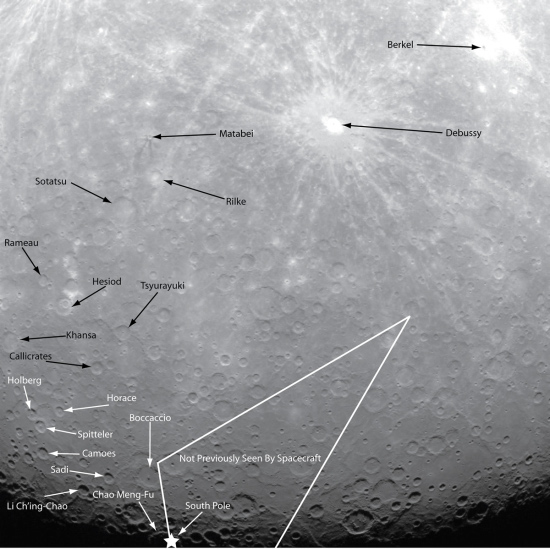The strange fluctuating polar vortex over Venus’s pole
The strange fluctuating polar vortex over Venus’s south pole.
The strange fluctuating polar vortex over Venus’s south pole.
The strange fluctuating polar vortex over Venus’s south pole.
Kepler does asteroseismology on 500 sunlike stars. The data says that the theories of star formation need to be revised.
Newly discovered asteroid follows the Earth as it orbits the Sun, and has been doing it for a quarter million years.
Currently, three other horseshoe companions of the Earth are known to exist but, unlike 2010 SO16, these linger for a few thousand years at most before moving on to different orbits. Also, with an estimated diameter of 200–400 metres, 2010 SO16 is by far the largest of Earth’s horseshoe asteroids. The team has already used the Las Cumbres Observatory’s Faulkes Telescope in an on-going campaign to track the object and refine its orbit further. “It is not that difficult to spot with a medium-sized professional telescope”, says Dr Asher. “It will remain as an evening object in Earth’s skies for many years to come.”
Scientists have found strong evidence that liquid water once existed in the interior of a comet.
The ripples in the rings of Saturn and Jupiter were caused by comet impacts decades ago.

Above, an annotated version of the first orbital image, showing areas of the south pole never before seen.
From the press conference about the first Messenger images from Mercury orbit:
» Read more
Which near-Earth asteroids are ripe for a visit?
When is an asteroid not an asteroid?
The layered structure of Vesta (core, mantle and crust) is the key trait that makes Vesta more like planets such as Earth, Venus and Mars than the other asteroids, McCord said. Like the planets, Vesta had sufficient radioactive material inside when it coalesced, releasing heat that melted rock and enabled lighter layers to float to the outside. Scientists call this process differentiation.
This question immediately demonstrates once again the terrible mess the International Astronautical Union made when it decided several years ago to define what makes a planet, and came up with a definition that simply doesn’t work. For if Vesta should be considered a planet, why not Pluto?
The first image from Mercury orbit.
The brightest supernovae yet found.
Supernova 2008am is 3.7 billion light-years away. At its peak luminosity, it was over 100 billion times brighter than the Sun. It emitted enough energy in one second to satisfy the power needs of the United States for one million times longer than the universe has existed.
Get those telescopes out! A asteroid, a quarter-mile in diameter, is going to pass only 200,000 miles from the Earth on November 8, 2011. Key quote:
Although classified as a potentially hazardous object, 2005 YU55 poses no threat of an Earth collision over at least the next 100 years. However, this will be the closest approach to date by an object this large that we know about in advance and an event of this type.
X-ray stripes in the expanding remnant of a supernova explosion.
Mining and jobs versus radio astronomy.
All systems go! Dawn did a camera and instrument checkout last week, in preparation for its summertime arrival at the asteroid Vesta.
Two stars fusing into one.
The mess from the NASA space war spreads: Three European space science missions are now on their own after the U.S. the space agency pulls funding.
The earthquake moved Japan’s coast eight feet while shifting the Earth’s axis about four inches.
No, the “supermoon” didn’t cause the Japanese earthquake.
An evening pause: The music is beautiful, but the images tell us how far astronomy has changed our perception of the universe in the last few decades.
Astronomers from the University of Hawaii have taken new images of the potentially dangerous asteroid Apophis in an effort to refine their understanding of its orbital path.
A mature galaxy cluster has been found by astronomers at a time when the universe is thought to be only a quarter of its present age.
This discovery could be very significant, since astronomers think mature galaxy clusters need time to form, and shouldn’t exist in the early universe. “If further observations find many more [of these clusters] then this may mean that our understanding of the early Universe needs to be revised.”
Did you hear the news? Scientists have solved the mystery of the missing sunspots!
You didn’t? Well, here’s some headlines and stories that surely prove it:
The trouble is that every one of these headlines is 100 percent wrong. The research, based on computer models, only found that when the plasma flow from the equator to the poles beneath the Sun’s surface slows down, the number of sunspots declines.
» Read more
The sponge-like Saturn moon. Key quote:
Hyperion measures about 250kms across; it rotates chaotically and has a density so low that it might house a vast system of caverns inside.
R.I.P. Leif J. Robinson, who served as editor of Sky & Telescope for twenty years, passed away Sunday at the age of 71 at his home in Costa Rica.
Take a gander at this spectacular image of the shuttle approaching ISS, taken by an amateur astronomer from the ground!